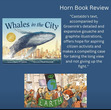Congratulations, Shruthi Rao, on WHEN SCIENCE STOOD STILL!
Thank you so much for sharing the release of “WHEN SCIENCE STOOD STILL: How S Chandrasekhar Predicted the Existence of Black Holes” with us! Young readers love STEAM books and I’m sure yours will find many happy readers. Can you share with us a bit about the inspiration for this book? What was your initial spark? Back in the early 2000s, my father urged me to read CHANDRA: A biography of S Chandrasekhar, by Kameshwar C Wali. It left a deep impression on me. I couldn’t get past how this young man made an incredible discovery about the death of stars – essentially he figured our using just mathematic calculations that such a thing as a black hole exists – and instead of his idea being welcomed, the scientific community ridiculed, and then ignored him. And yet, he was able to move past the disappointment and go on to do great things anyway. I’ve wanted to share this story with the world for a long time now.
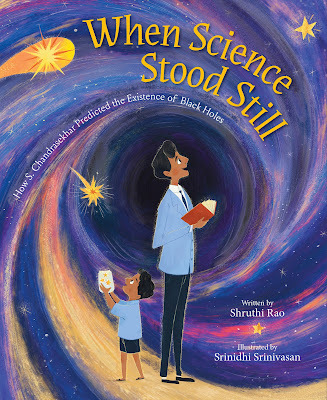 Writing STEAM books requires a substantial amount of research. Often it is the most fun part of our writing process. Did you meet any challenges in your research journey? I have a masters degree in engineering, and I’m comfortable with most things science and math. But astrophysics? That’s an entirely different thing! So for me, the biggest challenge was not just to understand the concepts of the birth and death of stars and the theory of black holes, but to express it in simple, clear terms.
Writing STEAM books requires a substantial amount of research. Often it is the most fun part of our writing process. Did you meet any challenges in your research journey? I have a masters degree in engineering, and I’m comfortable with most things science and math. But astrophysics? That’s an entirely different thing! So for me, the biggest challenge was not just to understand the concepts of the birth and death of stars and the theory of black holes, but to express it in simple, clear terms.
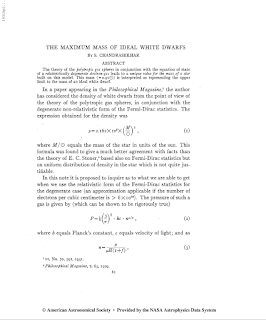 Often one of the most difficult parts of crafting our books is not deciding what to include, but deciding what to leave out. What did you choose to leave out of this book and why? One of the most fascinating things about Chandra’s story is that he remained on cordial terms with Arthur Eddington, in spite of the latter’s startling betrayal. I read two biographies of Chandra’s, read transcripts of his oral history interviews, listened to some interviews, and yet, I am not even close to understanding how he could bring himself to remain friendly with Eddington. Obviously, this bit didn’t fit into the picture book in any shape or form, so it wasn’t too hard of a decision to leave it out.
Often one of the most difficult parts of crafting our books is not deciding what to include, but deciding what to leave out. What did you choose to leave out of this book and why? One of the most fascinating things about Chandra’s story is that he remained on cordial terms with Arthur Eddington, in spite of the latter’s startling betrayal. I read two biographies of Chandra’s, read transcripts of his oral history interviews, listened to some interviews, and yet, I am not even close to understanding how he could bring himself to remain friendly with Eddington. Obviously, this bit didn’t fit into the picture book in any shape or form, so it wasn’t too hard of a decision to leave it out.
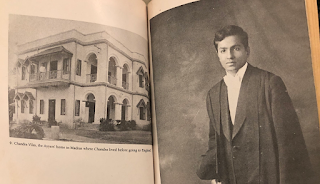 What tip can you share with teachers who want to use your book in the classroom? I would love it if teachers use this book to highlight the power of reading and learning widely. Chandra was able to find connections between different subjects, and apply what he learned from one source, to what he learned from another source, and come up with a completely new idea. Another thing this story shows is the wisdom of letting go. We talk about perseverance all the time as a valuable skill, and it is! But there is a lot to be said for learning to recognize when to let go and move on. If Chandra had gone on and on endlessly, trying to convince the scientific community which at that time just wasn’t ready to listen, imagine the frustration he would’ve experienced! Would he ever have been able to achieve all that he did if he hadn’t moved on? (inside spread)
What tip can you share with teachers who want to use your book in the classroom? I would love it if teachers use this book to highlight the power of reading and learning widely. Chandra was able to find connections between different subjects, and apply what he learned from one source, to what he learned from another source, and come up with a completely new idea. Another thing this story shows is the wisdom of letting go. We talk about perseverance all the time as a valuable skill, and it is! But there is a lot to be said for learning to recognize when to let go and move on. If Chandra had gone on and on endlessly, trying to convince the scientific community which at that time just wasn’t ready to listen, imagine the frustration he would’ve experienced! Would he ever have been able to achieve all that he did if he hadn’t moved on? (inside spread)
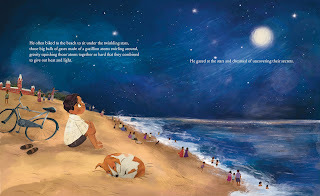 Congratulations on this book release! What comes next for you? Can you give us a peek at what you are currently researching? I’m currently doing what I like to call “feasibility research” into three different topics – one is history+STEM, another is history+food and the third is STEM+biography. Let’s see if any of them will stick!
Congratulations on this book release! What comes next for you? Can you give us a peek at what you are currently researching? I’m currently doing what I like to call “feasibility research” into three different topics – one is history+STEM, another is history+food and the third is STEM+biography. Let’s see if any of them will stick!
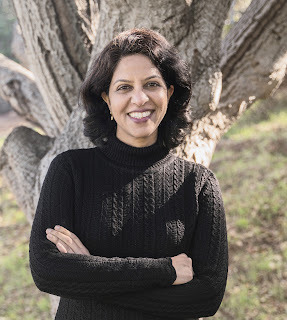 About the author: Shruthi Rao writes books for children. She is the author of 18 fiction and nonfiction books published in India and the US. She made her American publishing debut in 2024 with Kadooboo!: A Silly South Indian Folktale, which is an NYPL Best Book 2024. Shruthi has a masters degree in energy engineering and worked for a few years in tech before becoming a writer. Originally from India, Shruthi now lives in California. She loves desserts, benches and long walks.
About the author: Shruthi Rao writes books for children. She is the author of 18 fiction and nonfiction books published in India and the US. She made her American publishing debut in 2024 with Kadooboo!: A Silly South Indian Folktale, which is an NYPL Best Book 2024. Shruthi has a masters degree in energy engineering and worked for a few years in tech before becoming a writer. Originally from India, Shruthi now lives in California. She loves desserts, benches and long walks.
 Writing STEAM books requires a substantial amount of research. Often it is the most fun part of our writing process. Did you meet any challenges in your research journey? I have a masters degree in engineering, and I’m comfortable with most things science and math. But astrophysics? That’s an entirely different thing! So for me, the biggest challenge was not just to understand the concepts of the birth and death of stars and the theory of black holes, but to express it in simple, clear terms.
Writing STEAM books requires a substantial amount of research. Often it is the most fun part of our writing process. Did you meet any challenges in your research journey? I have a masters degree in engineering, and I’m comfortable with most things science and math. But astrophysics? That’s an entirely different thing! So for me, the biggest challenge was not just to understand the concepts of the birth and death of stars and the theory of black holes, but to express it in simple, clear terms.
 Often one of the most difficult parts of crafting our books is not deciding what to include, but deciding what to leave out. What did you choose to leave out of this book and why? One of the most fascinating things about Chandra’s story is that he remained on cordial terms with Arthur Eddington, in spite of the latter’s startling betrayal. I read two biographies of Chandra’s, read transcripts of his oral history interviews, listened to some interviews, and yet, I am not even close to understanding how he could bring himself to remain friendly with Eddington. Obviously, this bit didn’t fit into the picture book in any shape or form, so it wasn’t too hard of a decision to leave it out.
Often one of the most difficult parts of crafting our books is not deciding what to include, but deciding what to leave out. What did you choose to leave out of this book and why? One of the most fascinating things about Chandra’s story is that he remained on cordial terms with Arthur Eddington, in spite of the latter’s startling betrayal. I read two biographies of Chandra’s, read transcripts of his oral history interviews, listened to some interviews, and yet, I am not even close to understanding how he could bring himself to remain friendly with Eddington. Obviously, this bit didn’t fit into the picture book in any shape or form, so it wasn’t too hard of a decision to leave it out.
 What tip can you share with teachers who want to use your book in the classroom? I would love it if teachers use this book to highlight the power of reading and learning widely. Chandra was able to find connections between different subjects, and apply what he learned from one source, to what he learned from another source, and come up with a completely new idea. Another thing this story shows is the wisdom of letting go. We talk about perseverance all the time as a valuable skill, and it is! But there is a lot to be said for learning to recognize when to let go and move on. If Chandra had gone on and on endlessly, trying to convince the scientific community which at that time just wasn’t ready to listen, imagine the frustration he would’ve experienced! Would he ever have been able to achieve all that he did if he hadn’t moved on? (inside spread)
What tip can you share with teachers who want to use your book in the classroom? I would love it if teachers use this book to highlight the power of reading and learning widely. Chandra was able to find connections between different subjects, and apply what he learned from one source, to what he learned from another source, and come up with a completely new idea. Another thing this story shows is the wisdom of letting go. We talk about perseverance all the time as a valuable skill, and it is! But there is a lot to be said for learning to recognize when to let go and move on. If Chandra had gone on and on endlessly, trying to convince the scientific community which at that time just wasn’t ready to listen, imagine the frustration he would’ve experienced! Would he ever have been able to achieve all that he did if he hadn’t moved on? (inside spread)
 Congratulations on this book release! What comes next for you? Can you give us a peek at what you are currently researching? I’m currently doing what I like to call “feasibility research” into three different topics – one is history+STEM, another is history+food and the third is STEM+biography. Let’s see if any of them will stick!
Congratulations on this book release! What comes next for you? Can you give us a peek at what you are currently researching? I’m currently doing what I like to call “feasibility research” into three different topics – one is history+STEM, another is history+food and the third is STEM+biography. Let’s see if any of them will stick!
 About the author: Shruthi Rao writes books for children. She is the author of 18 fiction and nonfiction books published in India and the US. She made her American publishing debut in 2024 with Kadooboo!: A Silly South Indian Folktale, which is an NYPL Best Book 2024. Shruthi has a masters degree in energy engineering and worked for a few years in tech before becoming a writer. Originally from India, Shruthi now lives in California. She loves desserts, benches and long walks.
About the author: Shruthi Rao writes books for children. She is the author of 18 fiction and nonfiction books published in India and the US. She made her American publishing debut in 2024 with Kadooboo!: A Silly South Indian Folktale, which is an NYPL Best Book 2024. Shruthi has a masters degree in energy engineering and worked for a few years in tech before becoming a writer. Originally from India, Shruthi now lives in California. She loves desserts, benches and long walks.
Published on October 14, 2025 04:00
No comments have been added yet.

